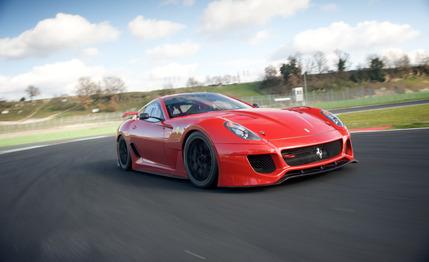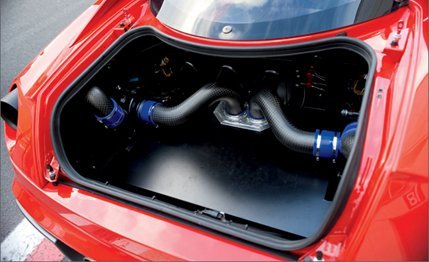 First Drive Review
First Drive Review
Strange things happen in Maranello. When Fiat flew us to Italy to showcase its technology in 1988, for instance, the company’s CFO personally set up a Ferrari factory tour for us. When we arrived, the guard at the gate said, “So sorry. If only we had known you were coming.” Then, when we were promised a drive in the first Enzo on Ferrari’s Fiorano test track, well, sorry again, because the factory’s F1 team had already booked the joint.
And now I was to be the second journalist in the world to drive the 599XX—an extreme 720-hp track-only iteration of the surpassingly gorgeous 599GTB Fiorano—except six inches of snow had muffled the Italian town the night before. As press officer Matteo Torre said of the now-invisible circuit, “She is only good for, how you say, the cross-country skis.”
Signor Torre, however (who, as far as I could tell, never stopped running or answering his cell phone for 72 hours), had ambitiously initiated Plan B. “I am having already renting of the Vallelunga, four hours south,” he explained, rubbing his hands like Ernst Blofeld. What’s more, he’d also already shipped two 599XXs there. “Vallelunga, she is the terrible fast track,” he added. “Much fun. But also many of the, uh, crashes enorme.” Then he noticed the look on my face. “Oh, no, Mister John. Not so much of our Ferraris is crashing.”
If ever there has existed a meaner, sleeker, dragon slayer of a GT racer, well, neither Ecclestone, Mosley, Lauren, nor Leno has clapped eyes on the thing.
Except for the roof and windshield, not much of the 599XX is cannibalized from the all-aluminum 599GTB Fiorano. All four fenders, for instance, feature F1-like aero “fences,” vertical panels behind which air is scooped out from each wheel well. To relieve heat and pressure, the hood likewise features nearly as many holes as Augusta. The winglets on the C-pillars—resembling Alfred E. Neuman’s ears—funnel air inward, forcing it to slide down the Lexan backlight, then along the ducktail trunklid, and finally over the carbon-fiber blade spoiler. And then there’s the huge underbody fairing and rear diffuser, whose center section is air permeable. Two electric fans mounted inside the trunk suck air through that permeable panel and then vent it through the holes previously occupied by taillights. The air is discarded in individual huffs and puffs (like a subwoofer stomping out rap music), which, we are told, detaches the wake from the rear of the car. This is apparently a good thing, according to the F1 engineers who designed it—along with the winglets—during hundreds of trial-and-error hours in Ferrari’s own wind tunnel. The fans automatically quit sucking underbody air at 155 mph, a speed that suggests the car is traveling in a straight line and thus needs no extra downforce. Speaking of which, all of this aero chicanery creates 617 pounds of downforce at 124 mph and 1389 pounds at 186 mph. For what started as a street car, that’s a bunch.
The cockpit is similarly all business, stripped to bare metal and encased in a roll cage. The dash is a piece of carbon fiber with a single LCD pod replacing all gauges, and LEDs embedded in the top of the steering wheel—as on the regular 599—warn of the approaching 9000-rpm redline. The side windows are Lexan; the doors feel as if they weigh 13 ounces; and the back seat is replaced with a tangle of Aeroquip hoses and what might be the black box from an Airbus A300.

By race-car standards, visibility is superb in all directions, helped in part by skinny, elongated side-view mirrors that jut out like individual Martian antennae. The cockpit offers one lone—and unlikely—vestige of civility: It’s air conditioned.
As a result of all that carbon fiber, not to mention the myriad luxo accouterments that have been returned to the parts bin, the 599XX is about 600 pounds lighter than a 3953-pound 599GTB Fiorano you’d see idling down Rodeo Drive.
The 6.0-liter V-12 makes 720 horsepower and 506 pound-feet of torque, besting the 599GTB’s output by 108 prancing horses and 58 pound-feet. Some of that newfound power accrues from upping the redline—9000 rpm instead of 8400—made possible through extra balancing, blueprinting, and sedulous massaging. There’s a new higher-flow carbon-fiber intake manifold, for instance; the pistons are graphite-coated; the cam lobes are polished to a Bulgari-quality fare-thee-well; mechanical tappets replace the hydraulic-istas; there’s a custom exhaust; and the crankshaft throws have a new aerodynamic profile.
The 599XX’s power-to-weight ratio is 4.7 pounds per horsepower, versus, say, the Bugatti Veyron’s 4.5. With telemetry as a witness, Ferrari test driver Raffaele De Simone spirited a 599XX to 100 km/h (62 mph) in 2.9 seconds—without launch control. But here’s maybe the coolest thing about the V-12: Ferrari warrants it for 5000 kilometers (3107 miles), “which should be good for two years’ worth of racing,” says chief vehicle engineer Nicola Porciani. A racing engine with a warranty. Is that a first? Because of noise regs at some tracks, the exhaust is fitted with silencers. Sadly, they impose a somewhat blatty V-8 note rather than the expected V-12 Bates Motel shriek.

Twin fans in the trunk (above) evacuate air from the huge underbody diffuser panel. Lead engineer Nicola Porciani (below) explains to the author that he should have worn a Nomex tie.

The gargantuan carbon-ceramic brakes are cooled by F1-derived “wheel donuts” that vent unwanted BTUs away from the rotors through slots around the wheels’ center-locking nuts. Automatic pneumatic jacks are part of the deal; the shocks can be toggled to three settings to suit the relative roughness of any given track; and the vital task of selecting gears is managed exclusively via paddles behind the steering wheel. Left paddle for downshifts, right paddle for upshifts. Hold the downshift paddle an extra half-second or so and you’ll automatically get multiple downshifts. It takes a little practice.
The 720 horsepower is a swell perk, but the dirty little secret to the 599XX’s boggling speed is its console-mounted “manettino,” which, translated loosely means “little handle.” It’s a rotary knob with nine positions, each of which alters the stability control’s level of aggression. Turn the manettino to position one, and there’s zero stability control, zero traction control. Turn it to nine, and the car is nearly uncrashable.